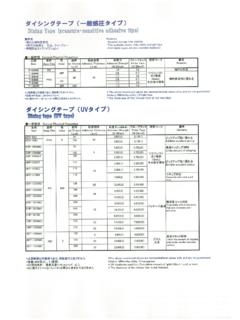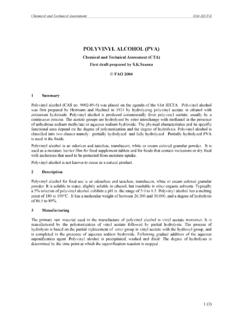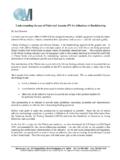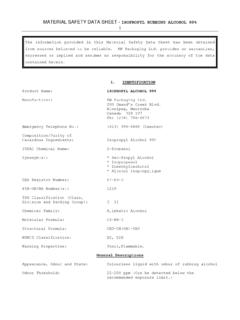Transcription of DENKA POVAL - ホーム
1 DENKA POVAL . ( polyvinyl Alcohol). Contents P 1. Process of DENKA POVAL P 1. cation & Grades of DENKA POVAL P 2. & Basic Properties of DENKA POVAL P 3 5. Applications of DENKA POVAL P 6 7. to Use DENKA POVAL P 8. Notice for DENKA POVAL P 9. DENKA POVAL . 1 Introduction DENKA POVAL is a water-soluble polymer described in below chemical formula, and provided as granule or powder form. POVAL ( polyvinyl alcohol) is used in a variety of elds because of its excellent properties such as water-solubility, adhesion strength, mechanical strength, gas barrier and aging resistance.. CH2 CH m CH2 CH . n Polymerization Degree m n .. OH OCOCH3 m Hydrolysis Degree 100 [%]. m n Fig. 1 Chemical Formula of POVAL . 2 Production Process of DENKA POVAL . DENKA POVAL is made from vinyl acetate monomer through polymerization and saponification processes. There are many grades available in the market according to different degrees of polymerization and hydrolysis, which are controlled in the polymerization and the saponification processes respectively.
2 CH2 CH Polymerization . CH2 CH l Saponi cation . CH2 CH m . CH2 CH . n .. OCOCH3 OCOCH3 OH OCOCH3. Vinyl Acetate polyvinyl Acetate POVAL ( polyvinyl Alcohol). Fig. 2 Production ow of DENKA POVAL . DENKA Omi-Plant 1. 3 Classi cation and Grades of DENKA POVAL . DENKA POVAL can be classified mainly with polymerization degree, which is often indicated as solution viscosity, and hydrolysis degree. Modified grades are also available to satisfy specified requirements. The most suitable grade can be selected from the range of DENKA POVAL . Table 1 DENKA POVAL General Grades List Hydrolysis Viscosity pH Volatile Sodium Product Shape Classi cation Grade Degree (4%, 20 ) (4%, 25 ) Matter Acetate [mol-%] [mPa s] [%] [%] G P F. K-05 . Fully K-17E 26 32 . Hydrolyzed K-17C 24 30 . K-24E 54 66 . H-12 10 15 . Medium H-17 25 31 . Hydrolyzed H-24 52 64 . B-05 . B-17 21 25 . Partially B-20 27 33 . Hydrolyzed B-24 40 48.
3 B-33 98 122 . * Product Shape : G = Granule, P = Powder, F = Fine Powder Table 2 DENKA POVAL Special & Unique Grades List Main Hydrolysis Viscosity pH. Classi - Product Shape Grade Characteristics Appli- Degree (4%, 20 ) (4%, 25 ). Cation cation [mol-%] [mPa s] G P F. K-17U6 Fine Powder Int. Binder 26 31 . DENKA POVAL . K-VG Fine Powder Int. Binder 24 30 . NP-05F Low Hydrolyzed Fiber (4 7) . EP-130 Hydrophobic Modifed Adhesive 110 180 . U-12 High Hydrolyzed Adhesive . PC-1000 for O set Printing Paper Fully Hydro. 20 30 . DENKA SIZE. PC-2000 High Barrier Property Paper Fully Hydro. 85 125 . PC-5000F Low Staining Property Paper Fully Hydro. 20 30 ( ) . PC-5500 Low Staining Property Paper Fully Hydro. 20 30 ( ) . W-100 Water Resistance Paper Fully Hydro. 500 1500* . D-100 Hydrophobic Modifed Adhesive 43 70* . HV Polymer F-300S Hydrophobic Modifed Binder 100 350* . B-24N High Dispersing Ability Emulsion 40 48.
4 W-20N High Dispersing Ability PVC 37 43 . Dispersant W-24N High Dispersing Ability PVC 44 55 . MP-10 Double Bond Modi ed PVC . MP-10R Double Bond Modi ed PVC . * Solid Content in Viscosity Measurement W-100 = D-100 = 2% D-300F = 3%. * Product Shape : G = Granule, P = Powder, F = Fine Powder DENKA SIZE : Suitable especially for fiber sizing, paper sizing and adhesive applications. Softness, water resistance, adhesion strength and wettability can be improved. HV Polymer : Modified grades suitable for adhesive and binder applications. Superior control can be provided in viscosity and bonding strength. Dispersant : Suitable for a dispersant or an emulsi er for the polymerization of vinyl acetate emulsion and vinyl chloride. High dispersing effect can be provided. 2. DENKA POVAL . 4 Characteristics and Basic Properties of DENKA POVAL . The characteristics of PVA are strongly in uenced from polymerization and hydrolysis degrees.
5 Figure 3 shows the relationship of polymerization and hydrolysis degrees of typical grades of DENKA POVAL . 100. K-05 K-17 K-24. H-12 H-17 H-24. Hydrolysis Degree [mol-%]. 90. B-05 B-17 B-20 B-24 B-33. 80 W-20N W-24N. MP-10R MP-10. 70. 60. 0 500 1000 1500 2000 2500 3000 3500. Polymerization Degree Fig. 3 Relation between Polymerization & Hydrolysis Degrees of DENKA POVAL . Figure 4 shows schematically the influences of polymerization and hydrolysis degrees against the basic properties of PVA. The performance of PVA changes widely in dependence with polymerization and hydrolysis degrees. Table 3 In uences of Polymerization and Hydrolysis Degrees against PVA Properties Polymerization Degree Hydrolysis Degree Low High Low High Solubility, Hygroscopicity Large Small Large Small Solution Viscosity Small Large Small Large Film Strength Small Large Small Large Emulsifying Capacity Small Large Large Small Examples of the experimental data of the effects of polymerization and hydrolysis degrees are shown in gure 4 13 in the next pages.
6 And basic properties of PVA are shown in Table 4. 3. 100 80. B-05. B-17. Surface Tension mN/m . 80. B-24 70. K-24. Solubility % . K-17E. 60 H-17. 60. K-05 K-17E K-24. 40. 50 B-24. 20 B-17. B-05. 0 40. 0 20 40 60 80 100 0 Temperature Concentration % . Fig. 4 Solubility of PVA Fig. 5 Surface Tension of PVA Solution 80 80. Tensile Strength N/mm2 . Tensile Strength N/mm2 . K-24 K-24. K-17E. 60 60. H-24. K-05 H-24. H-17 K-17E. B-24. 40 40 H-17. K-05. B-24. B-17 B-17. 20 B-05 20 B-05. 0 0. 0 500 1000 1500 2000 2500 3000 84 88 92 96 100. Polymerization Degree Hydrolysis Degree mol-% . Fig. 6 Strength of PVA Film (1) Strength of PVA Film (2). 120 30. Wood / Paper Adhesion Strength N/27mm . Moisture Absorption % . 100 25. B-05. K-24. 80 20. B-17. 60 15 K-17E. K-17E. B-24 K-24. 40 10. K-05. B-17. 20 5. B-05. 0 0. 0 500 1000 1500 2000 2500 3000 30 40 50 60 70 80 90 100. Polymerization Degree Relative Humidity [%].
7 Fig. 8 Adhesion Strengh of PVA Fig. 9 Hygroscopic Property of PVA. 4. DENKA POVAL . 100,000 100,000. 10,000 10,000. Viscosity mPa s . Viscosity mPa s . 1,000 1,000. 100 100. B-33. K-24 B-24. K-17E B-20. 10 B-17. 10 K-17C. B-05. K-05. 1. 1 0 5 10 15 20. 0 5 10 15 20. Concentration % Concentration % . Fig. 10 Solution Viscosity of PVA (1) Fig. 11 Solution Viscosity of PVA (2). 10 . 100,000 100,000. 20 10 . < K-17E > 30 < B-17 > 20 . 40 30 . 50 40 . 10,000 60 10,000 50 . 70 60 . Viscosity mPa s . Viscosity mPa s . 70 . 1,000 1,000. 100 100. 10 10. 1 1. 0 5 10 15 20 0 5 10 15 20. Concentration % Concentration % . Fig. 12 Solution Viscosity of K-17E Fig. 13 Solution Viscosity of B-17. Table 4 Basic Properties of PVA. Item Property Note Appearance White to light yellow, granule or powder Speci c Gravity Bulk Density Speci c Heat 103J/(kg ). Glass Transition Temp. 85 (Fully) / 58 (Partially) Depends on Hydrolysis Degree Heat Conductivity 2W/(m ).
8 Thermal Expansion 7 10 10-5/ Between 0 45 . Refractive Index (nD20) Electric Resistance 107 cm 5. 5 Typical Applications of DENKA POVAL . DENKA POVAL is widely used as a water-soluble polymer in a variety of elds because of its excellent properties such as adhesion, lm-forming and dispersing ability. Table 5 shows typical applications of PVA and suitable PVA grade for each application. Table 5 Typical Applications of DENKA POVAL . Applications Disper Shaped Const Fiber Paper Adhesive Binder sant Product ruction Span Filament Finishing Glue Surface Sizing Pigment Coating VAM Emulsion PVC. Papers Paper Band Remoistenable Urea Resin Internal Binder Ferrite Ceramics Agrichemicals Nursery Soil Soil Conditioner Film Sponge Mortar Admixture Fabric Binder Classi cation Grade K-05 . Fully K-17E . Hydrolyzed K-17C . K-24E . H-12 . Medium H-17 . Hydrolyzed H-24 . B-05 . B-17 . Partially B-20 . Hydrolyzed B-24.
9 B-33 . DENKA K-17U6 . POVAL K-VG . NP-05F . EP-130 . U-12 . PC-1000 . DENKA SIZE. PC-2000 . PC-5000F . PC-5500 . W-100 . D-100 . HV Polymer F-300S . B-24N . W-20N . Dispersant W-24N . MP-10 . MP-10R . * Note Suitable Fine powder is recommended Detailed report for each application is available. If required, please contact our sales department which is described on the back cover of this catalog. 6. DENKA POVAL . Typical Applications of DENKA POVAL . Vinylon Fiber Vinylon Film Emulsion Type Adhesive Glass Paper Fiber Sizing PVA Sponge 7. 6 How to Use DENKA POVAL . Usage of DENKA POVAL is brie y explained on this page. Detailed information is available on a request basis. Please contact our sales department, if required. 1) Dissolving Procedure Following procedure is recommended to dissolve PVA. Feed water into a tank at ambient temperature Water temperature should not be so high in order to avoid agglomeration.
10 Feed PVA gradually into the water with agitation and disperse it suf ciently. Especially low hydrolyzed grade should be taken care of. Heat up with continuous agitation and dissolve the PVA. More than 90 degree-C for minimum 30 minutes is recommended. Add water to adjust the concentration after complete dissolution of PVA. Actual concentration should be measured due to the water contained in PVA. If the grade has clouding point, cool down the temperature under the clouding point before use. Especially low hydrolyzed grade should be taken care of. 2) Additives Following additives are sometimes used for PVA to improve a speci ed property. Anti-foaming Agent Reduce the foam generation during dissolution. Water Resistant Additive Cross-linker is often used to improve water resistance. Plasticizer, softener Glycerin and glycols are widely used for PVA. Extender, Filler Starch, other water soluble polymer and clay are used.














